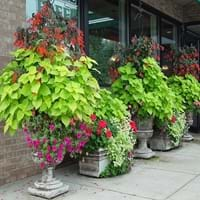Life Span
Annual and Perennial
Annual
Type
Bulb or Corm or Tuber
Vegetable
Origin
Central America, South America
Central America, Mexico
Types
Vine, Flowering plant
Slicing, Pickling and burpless
Habitat
All sorts of environments, Along Railroads, Banks, Moist Ditches, Roadsides, rocky banks of streams
Floodplains, Wet forest
USDA Hardiness Zone
10-13
7-8
Sunset Zone
21,22
A3, H1, H2, 1a, 1b, 2a, 2b, 3a, 3b, 4, 5, 6, 7, 8, 9, 10, 11, 12, 13, 14, 15, 16, 17, 18, 19, 20, 21, 22, 23, 24
Habit
Vining/Climbing
Vining/Climbing
Minimum Width
Not Available
Flower Color
Purple, Rose
Yellow, Gold
Flower Color Modifier
Bicolor
Bicolor
Fruit Color
Not Available
Green
Leaf Color in Spring
Purple, Dark Green, Black
Light Green
Leaf Color in Summer
Light Green
Green, Dark Green
Leaf Color in Fall
Several shades of Green
Green, Dark Green, Yellow green
Leaf Color in Winter
Light Green
Not Available
Leaf Shape
Acicular
Heart-shaped
Plant Season
Spring, Summer, Fall, Winter
Summer, Fall
Sunlight
Full Sun, Partial Sun
Full Sun, Partial Sun
Growth Rate
Very Fast
Very Fast
Type of Soil
Clay, Loam, Sand
Loam
The pH of Soil
Acidic, Neutral, Alkaline
Neutral
Soil Drainage
Well drained
Well drained
Bloom Time
Late Spring, Early Summer, Summer, Late Summer, Early Fall, Fall, Late Fall
Early Summer, Summer, Late Summer, Early Fall, Indeterminate
Tolerances
Drought
Drought
Where to Plant?
Container, Ground
Container, Ground
How to Plant?
Cuttings, Leaf Cutting, Tuber propagation
Seedlings, Stem Planting
Plant Maintenance
Medium
Medium
Watering Requirements
Keep the Soil well drained, Needs very little water
Keep ground moist, Requires a lot of watering, Requires regular watering, Requires watering in the growing season
In Summer
Lots of watering
Lots of watering
In Spring
Moderate
Moderate
In Winter
Average Water
Average Water
Soil pH
Acidic, Neutral, Alkaline
Neutral
Soil Type
Clay, Loam, Sand
Loam
Soil Drainage Capacity
Well drained
Well drained
Sun Exposure
Full Sun, Partial Sun
Full Sun, Partial Sun
Pruning
Remove damaged leaves, Remove dead branches, Remove dead leaves
Prune after flowering, Remove shoots
Fertilizers
All-Purpose Liquid Fertilizer
Compost, organic fertlizers
Pests and Diseases
Red blotch
Bacteria wilt, Fungal Diseases, fungus, Fusarium wilt, Leaf spot, Striped cucumber beetles
Plant Tolerance
Drought
Cold climate
Flower Petal Number
Single
Single
Foliage Texture
Coarse
Coarse
Foliage Sheen
Matte
Matte
Attracts
Aphids, Beetles, Cutworms, Insects, Mites, Whiteflies
Ants, Birds, Flying insects, Insects, Rats, Squirrels
Allergy
Abdominal pain, allergic reaction, Nausea, Skin rash, Twitching of face
Throat itching, Vomiting
Aesthetic Uses
Not Used For Aesthetic Purpose
Showy Purposes
Beauty Benefits
Not Available
Not Available
Environmental Uses
Air purification
Food for animals, Food for birds
Medicinal Uses
Cures constipation, Fiber, Low calories, lowering blood pressure, Potassium, ß-carotene, Vitamin A, Vitamin C
Antioxidants, Combats Stress, Fiber, Improve heart health, Indigestion, Inflammation, Rich in Iron
Part of Plant Used
Leaves, Root, Shoots, Stem, Tuber
Fruits, Seeds
Other Uses
Starch, Used As Food, Used as Ornamental plant
Used As Food, Used as Ornamental plant, Used for its medicinal properties
Used As Indoor Plant
Sometimes
Yes
Used As Outdoor Plant
Yes
Yes
Garden Design
Container, Edible, Groundcover, Hanging Basket, Herb / Vegetable, Mixed Border, Rock Garden / Wall, Vine
Edible, Herb / Vegetable, Vine
Botanical Name
IPOMOEA batatas 'Blackie'
MELOTHRIA scabra
Common Name
Blackie Sweet Potato Vine, Sweet Potato Vine
Mexican Sour Gherkins, cucamelon
In Hindi
शकरकन्द
Mousemelon
In German
Süßkartoffel
Maus Melone
In French
Patate douce
Mousemelon
In Spanish
Ipomoea batatas
Mousemelon
In Greek
Sweet potato
πεπόνι ποντίκι
In Portuguese
Batata-doce
melão rato
In Polish
Wilec ziemniaczany
mysz melona
In Latin
Ipomoea batatas
mouse melon
Phylum
Tracheophyta
Tracheophyta
Class
Magnoliopsida
Magnoliopsida
Order
Solanales
Cucurbitales
Family
Convolvulaceae
Cucurbitaceae
Clade
Angiosperms, Asterids, Eudicots
Angiosperms, Eudicots, Rosids
Tribe
Not Available
Melothrieae
Subfamily
Not Available
Cucurbitoideae
Number of Species
Not Available
Not Available
Season and Care of Sweet Potato Vine and Mouse Melon
Season and care of Sweet Potato Vine and Mouse Melon is important to know. While considering everything about Sweet Potato Vine and Mouse Melon Care, growing season is an essential factor. Sweet Potato Vine season is Spring, Summer, Fall and Winter and Mouse Melon season is Spring, Summer, Fall and Winter. The type of soil for Sweet Potato Vine is Clay, Loam, Sand and for Mouse Melon is Loam while the PH of soil for Sweet Potato Vine is Acidic, Neutral, Alkaline and for Mouse Melon is Neutral.
Sweet Potato Vine and Mouse Melon Physical Information
Sweet Potato Vine and Mouse Melon physical information is very important for comparison. Sweet Potato Vine height is 15.00 cm and width Not Available whereas Mouse Melon height is 15.20 cm and width 180.00 cm. The color specification of Sweet Potato Vine and Mouse Melon are as follows:
Sweet Potato Vine flower color: Purple and Rose
Sweet Potato Vine leaf color: Purple, Dark Green and Black
Mouse Melon flower color: Yellow and Gold
- Mouse Melon leaf color: Light Green
Care of Sweet Potato Vine and Mouse Melon
Care of Sweet Potato Vine and Mouse Melon include pruning, fertilizers, watering etc. Sweet Potato Vine pruning is done Remove damaged leaves, Remove dead branches and Remove dead leaves and Mouse Melon pruning is done Prune after flowering and Remove shoots. In summer Sweet Potato Vine needs Lots of watering and in winter, it needs Average Water. Whereas, in summer Mouse Melon needs Lots of watering and in winter, it needs Average Water.





